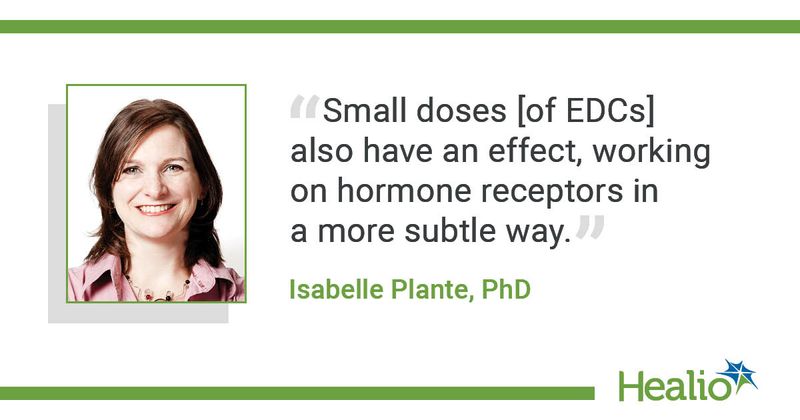New international group advocates for endocrine-disrupting chemical research, legislation
A new center devoted to the analysis of endocrine-disrupting chemicals will bring together researchers across disciplines to better collaborate and advocate for policies and legislation benefiting human and environmental health.
The Intersectoral Centre for Endocrine Disruptors Analysis (ICEDA), funded by the Institut National de la Recherche Scientifique (INRS) in Canada, is a multicenter strategic group designed to foster international collaboration between researchers from different disciplines interested in the study and analysis of endocrine disruptors. ICEDA research will focus primarily on environmental health, human health, water treatment, analytical chemistry, epidemiology and environmental policy. The group, co-founded by Valérie Langlois, PhD, associate professor at the INRS-Eau Terre Environnement Research Centre, and Isabelle Plante, PhD, associate professor at the INRS-Armand-Frappier Santé Biotechnologie Research Centre, already has more than 120 members across Canada, the United States and Europe.

Healio spoke with Plante about the generational effects of endocrine-disrupting chemical (EDC) exposure, the need for collaborative EDC research and policy goals for the new center.
How would you define an endocrine disruptor?
Plante: Endocrine-disrupting chemicals are everywhere — commonly found in many cosmetic products, the lining of cans, in nonstick cookware and even in water. They are mainly human-made compounds present in the environment that will interfere with the endocrine system at the hormone level. They can mimic hormones when they bind to receptors, or they can have an antagonizing effect or a blocking effect. The more we are studying them now, the more we have learned how EDCs also interfere with hormone metabolism. We now know that EDCs are not only working on the endocrine system, but also have other downstream effects.
What are some of the downstream effects of EDC exposure?
Plante: The reproductive effects are some of the most studied effects of EDC exposure. Researchers have linked EDC exposure to infertility in men and reproductive issues mainly in animals. Much of our data comes from animal studies. We are seeing a decrease in fish and amphibian populations exposed to EDCs in the water. Now, we are seeing effects on obesity, metabolism and even heart disease in humans. These are not new diseases, but new effects that are now attributed to EDC exposure.
What led to the formation of the ICEDA?
Plante: Many scientists are working on EDC research, but they work siloed in their own fields. Chemists are looking at the chemistry of EDCs. People like me are looking at the effect on human health and cancer. Biologists are looking specifically at the effect of EDCs on wildlife — all without talking to each other. The idea was to bring all of these people together. Let us collaborate with the people doing the toxicology studies. If they know, for example, what to measure in the water, we can test exactly what we are exposed to, and then we can better translate that to the people who are making policy on the dangers of EDCs. The idea was to put these people together, think together, and have the impact of one group.
What will be the center’s main mission, and how does it plan to carry that out?
Plante: The idea is to put together projects that will translate from basic science, to bench work, to human work. We hope to gather people together and tackle big research projects on EDCs. Our group is very young; we officially launched in November after receiving our funding in the spring. We already have about 120 members, mainly from Canada, but also from the United States, Argentina and Europe. We’re getting more and more requests from people who want to join us, which is really great.
Are there specific policy initiatives related to EDC exposures you want to target first?
Plante: The way most governments make policy worldwide is to look at the dose-response of EDCs. Researchers expose an animal to an increasing amount of a chemical, and when you see an effect, you say, “OK, that is the maximum level a human can be exposed to.” Then, legislation is based on that.
The problem with EDCs is that the more we study them, the more we realize that this method does not work. EDCs are mimicking hormones. If conducting a dose-response study, yes, of course you will reach toxicity at a certain point and see an effect. But when looking at a lower dose — the type of dose most humans are exposed to daily — you see what we call nonmonotonic doses. The small doses also have an effect, working on the receptors in a more subtle way. Some effects are generational. When you expose a pregnant woman to EDCs, you’re exposing the fetus and also the ovaries of the fetus. It’s very hard to make those links because those are long-term effects over time.
One of our biggest challenges is to change the way legislation is made when talking about an endocrine disruptor. We are not here to banish everything. We want to better understand the mechanisms of these chemicals and ensure legislation is based on EDC effects and not dose-response studies.
We also want to educate the population and help people better understand what they are exposed to and make good decisions about their habits and lifestyle.
Reference:
Institut National de la Recherche Scientifique (INRS). Available at: https://inrs.ca/. Accessed: Dec. 1, 2020.
Intersectoral Centre for Endocrine Disruptors Analysis (ICEDA). Available at: www.ciape-iceda.ca. Accessed: Dec. 2, 2020.
For more information:
Isabelle Plante, PhD, can be reached at Isabelle.plante@inrs.ca.
